The Victoria Park stalwart serving bold, faithful tastes of home to Perth’s Indonesian community
Cooking this good deserves a wider audience. Head to Batavia Corner for great fried chicken, house-made noodles and airy chocolate and peanut pancakes.
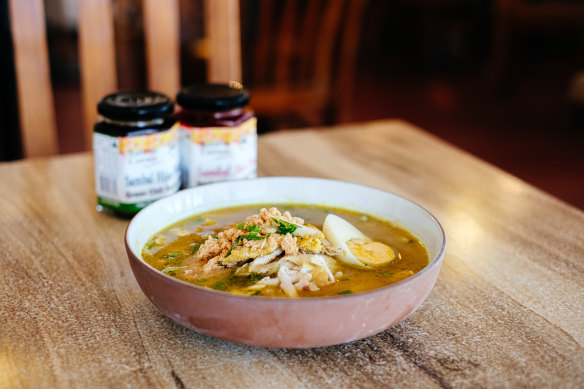
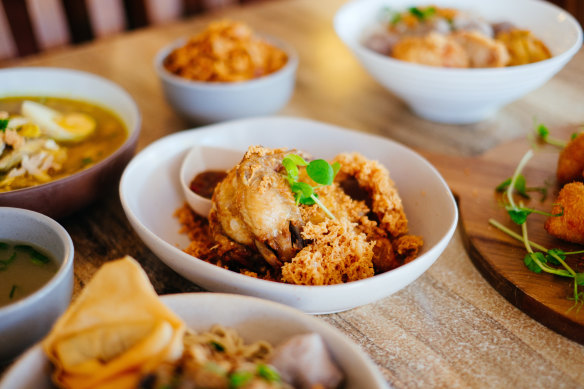
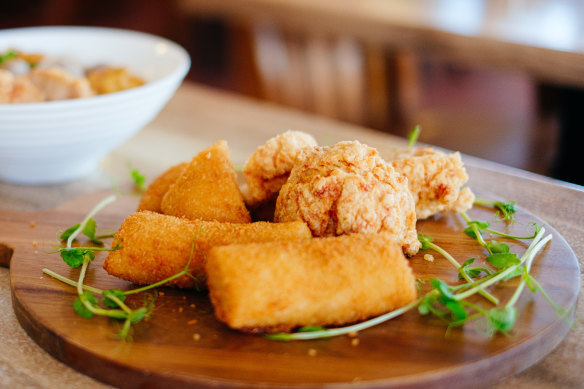
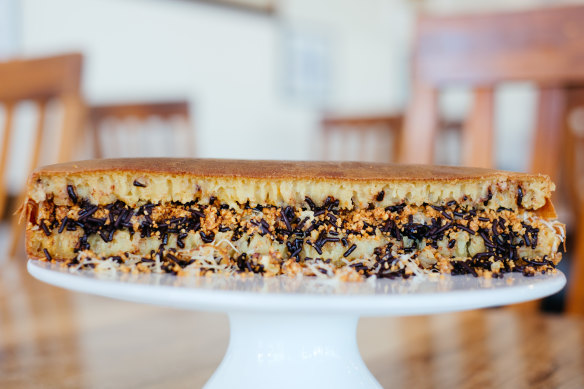
14/20
Indonesian$$
Why isn’t Indonesian food more popular in Perth? It’s a question I find myself frequently screaming into the abyss.
Admittedly, as someone that grew up in Medan in Sumatra, I’m far from a neutral observer. But taken purely on makanan Indonesia’s merits – it’s bold, it’s spicy, it’s sweet, it’s colourful! – I struggle to understand why Indonesian food doesn’t enjoy the same hype and coverage that, say, Thai, Korean and Vietnamese cooking does.
Having said that, it’s been encouraging to note a rise in local Indonesian restaurant numbers over the past decade. Much of this activity has taken place along the food wonderland that is Albany Highway. Ah Beng Indonesia, for one, swapped a Langford strip mall address for a flash shopfront at Westfield Carousel. At the western car-dealership end of the highway, Ria Ayam Penyet and Dapur Van Java also fly the flag for the archipelago’s cuisine.
The longest standing member of the Indonesian restaurant community on Albany Highway – and, indeed, Perth – is Batavia Corner: an understated yet cheery diner near Vic Park landmark and watering hole, The Balmoral Hotel.
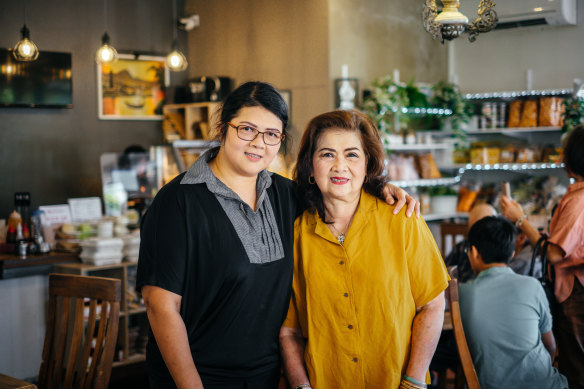
While Batavia’s Perth story began in 1998, the book’s earlier chapters were started in 1987, when owners Olly Djatmiko and Robby Theng opened Soto Ambengan Kelapa Gading in Jakarta. As the restaurant’s name hints at, its specialty is soto ayam Ambengan, a chicken soup that originated on and is named after Ambengan Street in the Javanese port city of Surabaya.
The shop and its soto ayam developed a following: so much so that the soup followed the couple to Australia and became one of three dishes on their opening menu. I haven’t had the Jakarta original, but I’ll attest to the pure comfort of Batavia’s rendition ($18). What’s not to love about a bowl heavy with shredded chicken and supple, threadlike rice noodles, all submerged by a turmeric-stained broth rendered lush by koya: a powder of crushed prawn crackers and garlic that acts as both condiment and thickener? Like the soup’s spice paste, this koya is one of many Indonesian ingredients and foodstuffs imported by the restaurant in its quest to faithfully recreate the tastes of Java.
The other two dishes from that first menu remain on active duty and – like the soup, Djatmiko and Theng – are also Javanese in origin. One is the rujak cingur ($16), a salad-esque plate of apple, pineapple and steamed veg smothered in a deep brown sauce marrying peanuts with the intense deep-sea funk of petis udang: shrimp paste’s wilder unkempt cousin made with prawn shells.
While some might describe this rujak as an acquired taste, I predict no such issue with the fried chicken (ayam goreng; $10), especially if you go the option showered with kremes: clouds of spiced (gluten-free!) flour that are crispier and more golden than approximately 99.9 per cent of all the ingredients that mankind has ever dunked into a deep fryer. Batavia’s version is inspired by the fried chicken at Yogyakarta’s legendary Ayam Goreng Suharti and uses the kremes to add all-important crunch to marinated, unbattered quarters of bird. One of the city’s great fried chickens.
Although Djatmiko ran the kitchen in those early days, the foundation for present-day Batavia was established in 2007 when daughter Shirley Theng returned to Perth to take over the family business after a stint teaching in Singapore. This transfer of power didn’t just see recipes being gently fine-tuned and tweaked (an untrained chef, Theng cites Google and YouTube as her major cooking influences): it also saw the menu undergo some major growth spurts.
Under Theng’s watch, beef became more of a focus, with Batavia’s menu exploring the pleasures and possibilities of the bovine universe. Tendon was cast as the unlikely hero of kikil ($14.90), a curry featuring slippery tubes of cow lolling in a spiced, coconut-based broth. Fried beef lung ($11) with fierce house-made chilli also made cameos. Then there’s the oxtail soup ($18), a well-seasoned, spiced joy of bone-in meat and broth that speaks to the influence the Dutch had on Indonesian food. While laden with chicken rather than beef, Batavia’s rissoles (soft ragout-filled crepes that are breaded then fried; two for $6) is another souvenir from Indonesia’s colonial era.
Finally, there’s the bakso, Indonesia’s famous beef balls rendered in all their springy, toothsome glory. While you can get your vitamin bakso in a number of ways, the most pleasurable form of consumption is as a soup component to one of the mie ayams (from $14.90), a tangle of plush house-made egg noodles tossed through minced chicken.
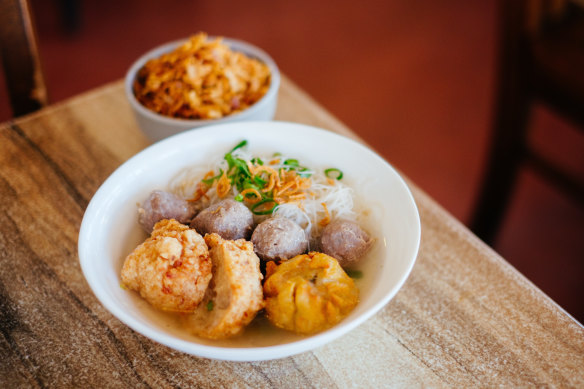
While Indonesia, I think it’s fair to say, has a collective sweet tooth, Indonesians don’t eat dessert, per se. Rather, sugary things are often snacked on throughout the day: a common pastime across Asia.
(“By some perverse logic,” writes David Thompson in his debut cookbook Classic Thai Cuisine, “snacks are not even considered real food [by Thais], merely a pleasant diversion to while away any spare time.“)
This attitude informs Batavia’s approach to afters. Instead of a dessert menu, guests browse a counter and shelves heavy with sweet and salty wondrousness that they can enjoy in situ or take home. Here’s some pre-wrapped bolo kukus, steamed sponge cupcakes with a remarkable likeness to blooming flowers. Those wedges of chiffon cake sure look mighty fine, don’t they? Jars of the restaurant’s pulse-quickening sambals make brilliant supplements to any chilli sauce collection.
But if you really wanted something somewhat dessert-like, head straight for the martabak manis: a plush, glossy pancake riddled with crumpet-like airholes sandwiching a dense, tarry mass of Dutch chocolate, smooshed into an underlay of finely crushed peanuts. Circa 2024, there are a lot of ways one can ingest empty carbs. This might be one of the most pleasurable. If you’re Malay, a friend probably introduced martabak manis to you as apam balik. Singaporeans, meanwhile, will recognise it by its local name, min jiang kueh.
My sole gripe about Batavia’s martabak is that it’s only sold by the box (from $17). Each box contains around a dozen pre-cut pieces of martabak. Depending on your beliefs surrounding chocolate and self-control, one box could represent anything from dessert for the entire table to a light supper for one. If Batavia Corner ever starts baking martabak manis to order and serving it warm, the queues that would inevitably follow could rival those at handmade bamboo noodle shop Yip across the road.

Like most Indonesian restaurants, Batavia’s menu is halal, yet management are fine with BYO. Crisp lagers or slippery, textured white wines would be an excellent drinks option, otherwise sugary Indonesian concoctions such as teh tarik, ice cendol and Indonesia’s famous jasmine-perfumed iced tea Teh Botol also offer respite against the menu’s frequent bursts of spice. Service is welcoming and efficient, just what you’d expect at this price-point and family-friendly style of restaurant.
So I wonder out loud again: why isn’t Indonesian food more popular in Perth? It’s not as if Indonesia is an unknown entity. Like the (tired) gag goes, Bali is referred to by some as our northernmost suburb. And despite the prevalence of Motel Mexicola and Finns in the plans and social media feeds of many Bali-bound locals, it’s impossible to visit the island and not encounter Indonesian food and culture.
What is possible, however, is choosing to ignore it, or choosing to lean into it. I think it’s obvious which team I’m on. And for those seeking somewhere to stretch that holiday out a little further – or somewhere to help wind your watch and mind forward to Bali-time before touchdown at Denpasar airport; or just somewhere eat delicious food booming with spice and flavour – I think it’s obvious where I’m going to direct you.
Another suburban gem and cornerstone for this city’s migrant community.
The low-down
Vibe: a homely, long-standing Vic Park Indonesian restaurant specialising in true-to-type tastes of Java island.
Go-to dish: ayam goreng kremes, martabak manis.
Drinks: sweet Indonesian teas, coffees and soft drinks that are ideal for fighting fire. BYO is also welcome.
Cost: about $65 for two, excluding drinks.
Restaurant reviews, news and the hottest openings served to your inbox.
Sign up